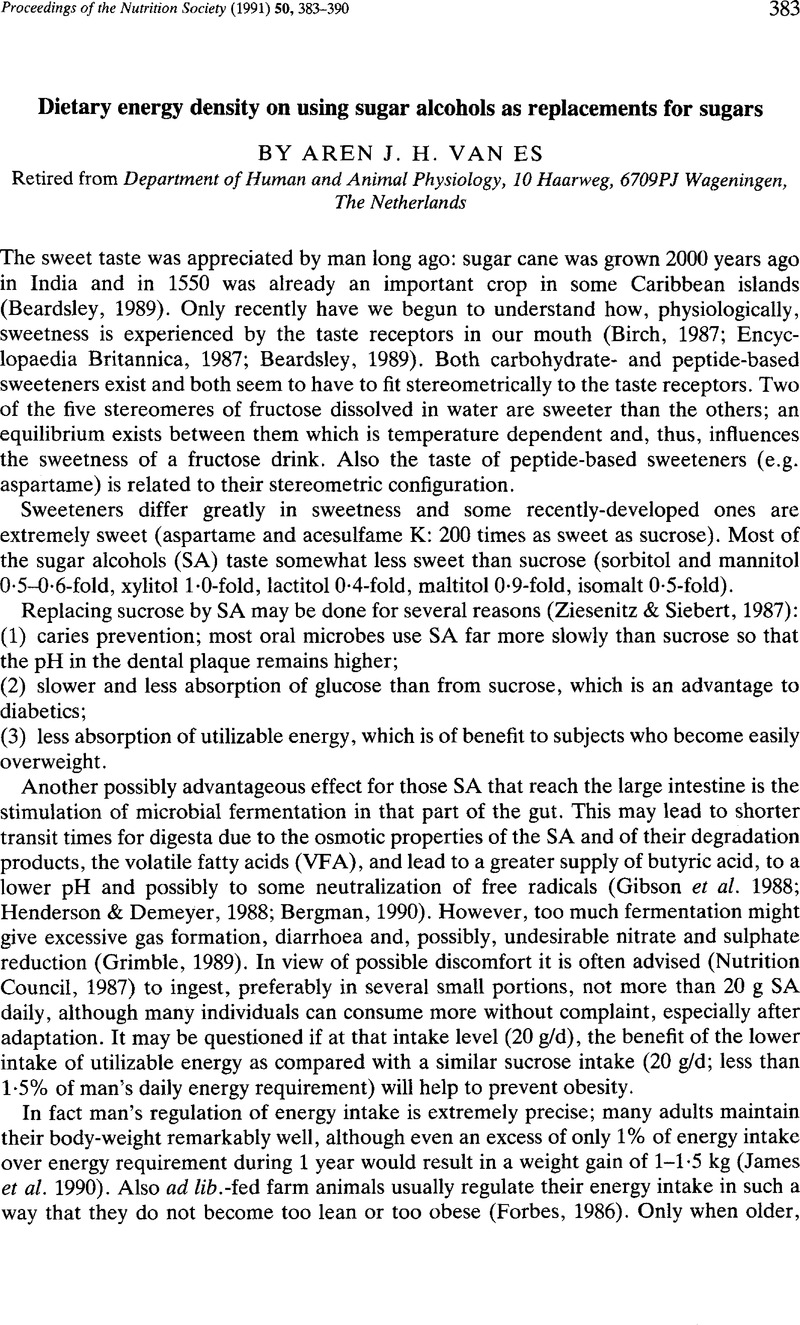Crossref Citations
This article has been cited by the following publications. This list is generated based on data provided by Crossref.
Livesey, G.
1992.
The Energy Values of Dietary Fibre and Sugar Alcohols for Man.
Nutrition Research Reviews,
Vol. 5,
Issue. 1,
p.
61.
Livesey, Geoffrey
1993.
Comments on the methods used to determine the energy values of carbohydrates: Dietary fibre, sugar alcohols and other bulking agents.
International Journal of Food Sciences and Nutrition,
Vol. 44,
Issue. 4,
p.
221.
Moe, Paul W
1994.
Future Directions for Energy Requirements and Food Energy Values.
The Journal of Nutrition,
Vol. 124,
Issue. ,
p.
1738S.
Ellwood, KC
1995.
Methods available to estimate the energy values of sugar alcohols.
The American Journal of Clinical Nutrition,
Vol. 62,
Issue. 5,
p.
1169S.
Livesey, G
1995.
Metabolizable energy of macronutrients.
The American Journal of Clinical Nutrition,
Vol. 62,
Issue. 5,
p.
1135S.
Ziesenitz, S. C.
1996.
Advances in Sweeteners.
p.
109.
Mela, David J.
1997.
Fat and sugar substitutes: implications for dietary intakes and energy balance.
Proceedings of the Nutrition Society,
Vol. 56,
Issue. 3,
p.
827.
Phillips, Glyn O.
1998.
Acacia gum (Gum Arabic): A nutritional fibre; metabolism and calorific value.
Food Additives and Contaminants,
Vol. 15,
Issue. 3,
p.
251.
Smith, Tracyn
Brown, Jacqueline C
and
Livesey, Geoffrey
1998.
Energy balance and thermogenesis in rats consuming nonstarch polysaccharides of various fermentabilities.
The American Journal of Clinical Nutrition,
Vol. 68,
Issue. 4,
p.
802.
Warwick, Penelope M.
and
Baines, Janis
2000.
Point of view: Energy factors for food labelling and other purposes should be derived in a consistent fashion for all food components.
British Journal of Nutrition,
Vol. 84,
Issue. 6,
p.
897.
Schiweck, Hubert
Bär, Albert
Vogel, Roland
Schwarz, Eugen
and
Kunz, Markwart
2000.
Ullmann's Encyclopedia of Industrial Chemistry.
Livesey, Geoffrey
2001.
A perspective on food energy standards for nutrition labelling.
British Journal of Nutrition,
Vol. 85,
Issue. 3,
p.
271.
Choi, Hae-Yeon
2009.
Antioxidant Activity and Quality Characteristics of Pine Needle Cookies.
Journal of the Korean Society of Food Science and Nutrition,
Vol. 38,
Issue. 10,
p.
1414.
Jung, Kyoo-Jin
and
Lee, Seung-Je
2011.
Quality Characteristics of Rice Cookies Prepared with Sea Mustard (Undaria pinnatifida Suringer) Powder.
Journal of the Korean Society of Food Science and Nutrition,
Vol. 40,
Issue. 10,
p.
1453.
Schiweck, Hubert
Bär, Albert
Vogel, Roland
Schwarz, Eugen
Kunz, Markwart
Lüssem, Bernd
Moser, Matthias
and
Peters, Siegfried
2011.
Ullmann's Encyclopedia of Industrial Chemistry.
Kim, Da-Mi
Kim, Kyoung-Hee
Yun, Young-Sik
Kim, Jae-Hun
Lee, Ju-Woon
and
Yook, Hong-Sun
2011.
Quality Characteristics of Cookies with Hot Water Extract of Seamustad (Undaria pinnatifida) Sporophylls and Treated with Gamma Irradiation.
Journal of the Korean Society of Food Science and Nutrition,
Vol. 40,
Issue. 11,
p.
1604.
Kim, Mi-Seon
Park, Jong Dae
Lee, Hyun Yu
and
Kum, Jun Seok
2013.
Effect of Rice Flour Prepared with Enzyme Treatment on Quality Characteristics of Rice Cookies.
Journal of the Korean Society of Food Science and Nutrition,
Vol. 42,
Issue. 9,
p.
1439.
Wu, Tian
Zou, Rui
Pu, Dian
Lan, Zengquan
and
Zhao, Bingyu
2021.
Non-targeted and targeted metabolomics profiling of tea plants (Camellia sinensis) in response to its intercropping with Chinese chestnut.
BMC Plant Biology,
Vol. 21,
Issue. 1,



